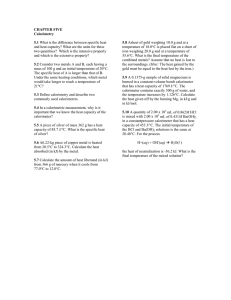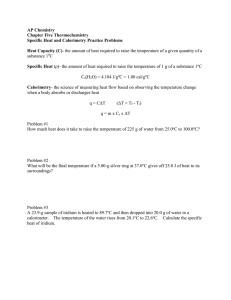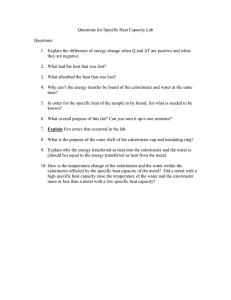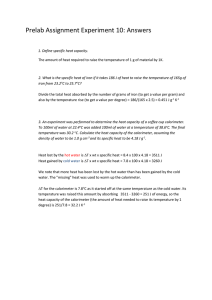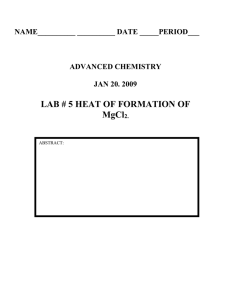Referensdosimetri
advertisement
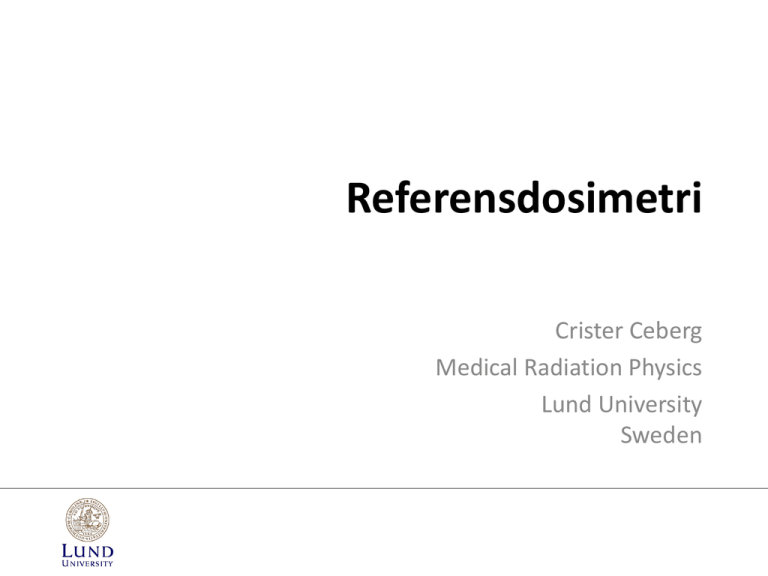
Referensdosimetri Crister Ceberg Medical Radiation Physics Lund University Sweden Reference dosimetry • Determination of absorbed dose to water under reference conditions • Not accounting for uncertainties related to non-reference conditions (for instance the patient...) • High accuracy is needed (~ 1.5%) • Requires a rigorous dosimetry protocol Reference dosimetry protocols • • • • • AAPM TG-51 (1999), North America DIN 6800-2 (1997, revised 2008), Germany NCS (1997), The Netherlands IPEMB (1996), UK IAEA TRS-398 (2000) IAEA TRS-398 • Published in 2000 • Replace previous protocol TRS-277 • Based on calibration of the instruments in absorbed dose to water IAEA TRS-398 http://www-naweb.iaea.org/NAHU/DMRP/codeofpractice.html International measurement system Traceability • Bureau International des Poids et Mesures (BIPM) 1875 – International Laboratory for SI units • Primary Standard Dosimetry Laboratory (PSDL) – – – – Widely acknowledged Highest metrological qualities Accepted without reference to other standards About 20 worldwide • Secondary Standard Dosimetry Laboratory (SSDL) – Depends on calibration at a PSDL • Clinical user at the hospital – Depends on calibration at SSDL or PDSL Primary standard laboratory (PSDL) • ISO definition of primary standard – “a standard that is designated or widely acknowledged as having the highest metrological qualities and whose values is accepted without reference to other standards of the same quantity“ • This requires an absolute dosimeter, – ”that can be assembled and used to measure the absorbed dose deposited in its own sensitive volume without calibration in a known field of radiation” (Attix) Absolute dosimeters • • • • Ionization chamber (BIPM) Fricke dosimeter (PTB until 2006) Water calorimeter (NIST, NRC, PTB since 2006) Graphite calorimeter (NPL) Ionization chamber • Graphite ion chamber with well defined volume • Designed to fulfill the Bragg-Gray conditions with very little perturbation Ionization chamber Boutillion and Perroche, PMB 38 (1993) Ionization chamber M/m W Boutillion and Perroche, PMB 38 (1993) Fricke dosimeter • • • • • Ferrous ions (Fe2+) in water Interaction with ionizing radiation leads radiolysis of water Iron ions are oxidized to ferric ions (Fe3+) The UV transmission spectrum is affected Response is determined by total absorption of electrons Fricke dosimeter Feist, PMB 27 (1982) Calorimeter • Measurable temperature increase in medium – Water – Graphite • Assumes that – All radiation energy is transfered to heat – All heat comes from radiation energy Calorimeter • Measures directly the absorbed energy per unit mass D=DTi·ci Increased temperature [K] Specific heat capacity [J kg-1 K-1] Calorimeter Ross and Klassen, PMB 41 (1996) Calorimeter Medin, Lund University Calorimeter AC R Variable R B Variable C R A DU = UA-UB Thermistors Medin, Lund University Calorimeter Bridge output voltage(V) 6 post-irradiation drift 4 2 0 DV -2 -4 -6 pre-irradiation drift -8 0 60 120 180 240 300 360 Time (s) Medin, Lund University Calorimeter • Requires several correction factors D=DTi·ci·kc·kp·kdd·(1-kHD)-1 kc: heat conductivity kp: perturbation due to glass container kdd: radiation field inhomogeneity kHD: heat defect Degree of equivalence http://kcdb.bipm.org/ Uncertainty in Dw (1SD) at PSDL • • • • • • • • • • • BIPM NIST NRC METAS PTB LSDG NMi ARPANSA BEV ENEA LNHB (ion chamber) (water calorimeter) (water calorimeter) (water calorimeter) (water calorimeter) (water calorimeter) (graphite calorimeter) (graphite calorimeter) (graphite calorimeter) (graphite calorimeter) (graphite calorimeter) 0.30% 0.35% 0.41% 0.41% 0.20% 0.66% 0.40% 0.20% 0.37% 0.44% 0.47% ND,W-based formalism Dw,Q0 =MQ0 ND,w,Q0 • Q0 denotes the reference beam quality at the standard laboratory • DW,Q0 is known at the standard laboratory • MQ0 is the dosimeter reading under reference conditions • ND,W,Q0 is the dosimeter’s ”absorbed-dose-to-water” calibration coefficient Correction for radiation quality Dw,Q =MQ ND,w,Q=MQ ND,w,Q0 kQ,Q0 • • • • Q denotes the quality at the user DW,Q is the absorbed dose in the user’s beam MQ is the dosimeter reading at the user kQ,Q0 corrects for the effects of the difference between the reference beam quality and the beam quality at the user The beam quality correction factor ND,w,Q Dw,Q /MQ kQ,Q0= = ND,w,Q0 Dw,Q0/MQ0 • Most often, the reference beam quality is 60Co, and then kQ,Q0=kQ Experimental determination of kQ,Q0 • Ideally, the kQ,Q0 factor should be measured for each chamber at the desired beam quality • However this requires – Standard laboratories with clinical beam qualities – Independent dosimetry (e.g. calorimeters) operating at these beam qualities Theoretical determination of kQ,Q0 • Instead, theoretically determined kQ,Q0 factors are tabulated in the IAEA TRS 398 protocol – for different chamber types – for different beam qualities 0.2% Beam quality • For photons TPR20,10 – TPR20,10=TPR(20)/TPR(10) – TPR20,10=1.2661 PDD20,10 – 0.0595 • For electrons R50 – Depth where absorbed dose is 50% of maximum – R50=1.029 R50,ion - 0.06 (R50,ion ≤ 10 cm) – R50=1.059 R50,ion - 0.37 (R50,ion > 10 cm) 6 MeV elektoner 100 90 80 Relativ dos 70 60 50 40 30 20 10 0 0 5 10 15 20 25 30 Djup i vatten (mm) 35 40 45 50 Practical details before use • Store instruments in a safe place (dry, normal room temperature, clean, etc.) • Inspect the instrument before use • Make an x-ray image of the instrument at the time of purchase, or if problems arise Stability check • Check and document long term stability (both detector and electrometer) • Perform stability check before and after the detector is sent for calibration at the standards laboratory Practical details during measurement • • • • • Allow time to reach thermal equilibrium Turn on the electrometer at least 1-2 h before use Always collect several measurements (5-10) Pay attention to trends (can be sign of equipment failure) Leakage should be < 0.1% of MQ Pre-irradiation effects • Pre-irradiate the chamber to reach charge equilibrium in the exposed materials • After change of voltage or polarity, be careful with restabilisation (> 20 min), consider using normalisation to an external monitor chamber Pre-irradiation effects • Normalized response for an NE 2571 to 60Co irradiation McCaffrey et al. PMB 2005 Correction of MQ for influence quantities MQ=M kTP kelec kpol ks • • • • • • Uncorrected reading: M Temperature and pressure: kTP Electrometer correction factor: kelec Polarity effect: kpol Recombination effect: ks Humidity: kh (rarely used) Correction of MQ for influence quantities MQ=M kTP kelec kpol ks • • • • • • Uncorrected reading: M Temperature and pressure: kTP Given by the SSDL Electrometer correction factor: kelec together with ND,w Polarity effect: kpol Recombination effect: ks Not needed if calibrated Humidity: kh (rarely used) at 50% humidity (20-80%) Temperature and pressure • The temperature and pressure correction converts the cavity air mass to the reference conditions: (273.2+T) P0 kTP= (273.2+T0) P where the reference conditions generally are – T0=20 C – P0=101.3 kPa Polarity • Polarity correction for asymmetric charge collection (mean value of readings at both polarities): |M+|+|M-| kpol= 2M where M+ and M- are the readings at positive and negative polarity, respectively • If not performed at the standards laboratory, a correction for the relative effect can be done Recombination • The recombination factor corrects for incomplete charge collection using the ”two-voltage” method: M1 M1 ks=a0+a1 + a2 M2 M2 ( ) ( ) 2 where M1 and M2 are the readings at two different operating voltages V1 and V2, such that V1 ≥ 3 V2, and a0 - a2 are constants found in the TRS 398 protocol • If not performed at the standards laboratory, a correction for the relative effect can be done Reference dosimetry in the user beam • The absorbed dose to water is then given by Dw,Q =MQ ND,w,Q0 kQ,Q0 where MQ is corrected for influence quantities, and kQ,Q0 is determined based on the user’s beam quality Reference dosimetry in the user beam • Take care that the linac is operating properly! • If not, accurate reference dosimetry can be a source of errors

